Review: Primera Pagina. Poetry from the Latino Heartland.
Kansas City, MO: 2008
ISBN 978-0-9791291-1-7
Michael Sedano
A few weeks ago, at the National Latino Writers Conference, I had the pleasure of hearing several of the women read their work included in this welcome anthology coming to us out of Kansas City, Missouri. These are effective, competent voices that fit well into the encompassing genre of "Chicana Chicano" arts.
"Latino" in the subtitle lets the collection cover a lot of ground, but principally this collection features Chicana Chicano poets. Which is to say, the poems reflect many of the themes and images that have populated poesía chicana over the years.
Among the preponderant themes echoed in this collection is the "lost and ruined homeland" that evokes places like barrios or Aztlán. Here, the subtitle, "from the Latino Heartland" places all the works into that geographic perspective. We may write in Kansas, the theme suggests, but we're from someplace else, the same place as the rest of you, the rest of us.
One expression of place is Gabriela N. Lemmons' "Kansas," where the poet declares, "I know when they harvest winter wheat,/ when corn needs to be planted, and how/ close to God people think they are. / But I don't know one multi-tongued latino, / where I can buy pumpkin empanadas, / dulce de leche and De La Rosa Mazapán. / Whether La Llorona roams in white or black /in these parts and what creeks she frequents? / I cannot remember how/ a wetback smells anymore, / soon after he crosses el Río Grande-- / the vein of my roots meandering / in hues of azul."
Lemmons adopts a tactic of footnoting all her Spanish phrases for the English-only reader. Empanadas (italicized in the note, not in the poem) are pies; dulce de leche is caramel; mazapan (sans diacritic) is peanut butter candy; La Llorona is the legendary wailing woman (Mexican Tale); azul is blue.
Another commonly read theme, the Anglo as devil, the exploitation of gente by officialdom, comes in for an interesting twist in Chato Villalobos' "Brown Eyes in Blue". The twist is the poet writes in the voice of a police officer who believes his presence brings security and justice to his pueblo. Aware of the contradiction, the poet writes, "I hesitate before looking in the mirror / That's when visions of Malinche appear / Because nothing really looks out of place / Until I see the brown skin of my own face." Pride of position overcomes fear of contradiction as the poem resolves with the thought, "The barrio calls for me I can't refuse / 'Cause I know they'll be safe with brown eyes in blues."
Not every writer attempts to put an ethnic or cultural gloss on their work. For instance, José Faus' work covers 28 pages of work that defies its placement in a "Latina Latino" collection. In contrast, Xánath Caraza writes facing-page bilingual poems. Speaking of language, English is the mode of expression for these pages.
Primera Página is a delightful collection of relatively new voices--the opening poet is San Diego's Taco Shop Poet, Tomas Riley. Aside from the pleasure of finding promising new poets, I found an excellent approach to these poets is reading the women first, then the men. An opportunity for dialog emerges from this approach. Some women expose the brutality of abusive men, as when Linda Rodriguez' "P.O.W." recounts the savagery of sexual abuse of a 9-year old girl by her father. The men are oblivious to these charges. To them, women are objects for play and seduction, as in Andrés Rodriguez' "Chronicle of a Salvadorian Girl," whose saving grace is the man and woman are clueless together. I would think the follow-up volume will bring these disparate points of view into confrontation. Since the anthology is product of a collective, I hope they'll do this and let us see what emerges.
One Bit: Printmaking and BBQ in Highland Parque.
Grand Opening
Sunday, June 22, 2008 @ 5:00 pm
Sonia Romero’s Printmaking Studio
Museum of Traffic, LLC
and
Launching of community partner LACommons’s website (www.lacommons.org)
Sunday, June 22, 2008 starting at 5:00 pm
Please join us for a barbeque/barbacoa afternoon as we celebrate the new at the Avenue 50 Studio
Food ~ Music ~ Art
Plus, a demonstration of printmaking by Sonia Romero
We invite you to join us and bring a refreshment or food in celebration
Avenue 50 Studio(s), Inc.
131-135 No. Avenue 50
Highland Park, CA
90042
323/258-1435
Bit Two: Latinos in Lotusland reading and book signing. Among the major independent booksellers on the eastside of the Los Angeles basin is Vroman's, in Pasadena. The two locations don't stock a lot of Chicana Chicano literature, so it was a pleasant surprise to read that the store was to host an evening of writers featured in the Daniel Olivas-edited anthology.
Among the major independent booksellers on the eastside of the Los Angeles basin is Vroman's, in Pasadena. The two locations don't stock a lot of Chicana Chicano literature, so it was a pleasant surprise to read that the store was to host an evening of writers featured in the Daniel Olivas-edited anthology.
It was a pleasantly full house of readers and writers who attended to enjoy some stimulating presentations. Most encouraging was the energetic jostle after the readings and Q&A. Vroman's must have sold a goodly number of the increasingly popular title. I hope the attendance and sales persuade Vroman's to host more Chicana Chicano Latina Latino writers.
Sandra Ramos O’Briant. Lana Turner Slept Here.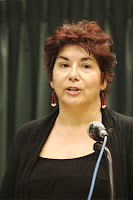 O'Briant clearly practiced her reading, plus she's an effective reader. But beyond that, O'Briant went to the extra effort to pare her story down to what she felt was a manageable time, and read from a typescript rather than the book. Two strangers in a chance encounter share painful marriage stories and learn that caring for others has a price, and it's probably worth it.
O'Briant clearly practiced her reading, plus she's an effective reader. But beyond that, O'Briant went to the extra effort to pare her story down to what she felt was a manageable time, and read from a typescript rather than the book. Two strangers in a chance encounter share painful marriage stories and learn that caring for others has a price, and it's probably worth it.
Victorio Barragán. Daylight Dreams. Barragan shared his first published work, a tale of bitter irony and crashing expectations. A shy man has admired a cute woman who rides his bus. He's worked up a romantic fantasy about the stranger. Today he will talk to her. In his dreams she will instantly respond and a long, happy relationship will come of it. Dashed. A slick jerk steals his woman from him and the bus pulls away with the woman happily flirting with the other guy. Carpe diem, loverboy.
Barragan shared his first published work, a tale of bitter irony and crashing expectations. A shy man has admired a cute woman who rides his bus. He's worked up a romantic fantasy about the stranger. Today he will talk to her. In his dreams she will instantly respond and a long, happy relationship will come of it. Dashed. A slick jerk steals his woman from him and the bus pulls away with the woman happily flirting with the other guy. Carpe diem, loverboy.
Conrad Romo. The Cement God. Romo's powerful voice enhances this gem of a boy-fatherhood story. Capturing small details of a boy's front stoop conversation with his grandfather, a master cement finisher, the tale sparkles with genuine warmth. The story favorably evokes the powerful cement-pouring scene from Richard Vasquez' novel, Chicano. In fact, Olivas has included that scene as the final entry of the anthology.
Romo's powerful voice enhances this gem of a boy-fatherhood story. Capturing small details of a boy's front stoop conversation with his grandfather, a master cement finisher, the tale sparkles with genuine warmth. The story favorably evokes the powerful cement-pouring scene from Richard Vasquez' novel, Chicano. In fact, Olivas has included that scene as the final entry of the anthology.
Lisa Alvarez. Sweet Time.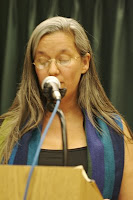 Alvarez' mother-daughter-stepsister story carries the tension of a mother's final stay in the hospital. The writer successfully conveys the distance that grows between families split apart by serial monogamy and alcoholism. Alvarez' dry humor gives the story added zest, transforming what could be a dreary tale of regret into something positive.
Alvarez' mother-daughter-stepsister story carries the tension of a mother's final stay in the hospital. The writer successfully conveys the distance that grows between families split apart by serial monogamy and alcoholism. Alvarez' dry humor gives the story added zest, transforming what could be a dreary tale of regret into something positive.
Daniel Olivas. Bender.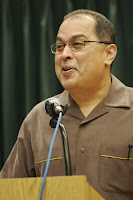 Olivas' metaphorical critter story has a lot of sexuality packed into such a tight space. Reprinted from his collection Devil Talk, it's a gem of perplexity that will have readers going back to page one to reassure themselves they've grasped what the writer told them. "Bender," as the other stories read that evening, is a delight.
Olivas' metaphorical critter story has a lot of sexuality packed into such a tight space. Reprinted from his collection Devil Talk, it's a gem of perplexity that will have readers going back to page one to reassure themselves they've grasped what the writer told them. "Bender," as the other stories read that evening, is a delight.
I'd like to encourage authors to develop fuller eye contact with the house. O'Briant's strategy of practicing and using a typescript allow her the luxury of pulling eyes off the page and looking out at her listeners. Too often a reader briefly glances up--I wonder if they even see what's before them--then glues the eyes to the page. Lecterns are unfriendly instruments. The slanted desktop makes it difficult to display the book. Any photo of an author reading will benefit from including the cover in the shot.
A Sadness in This Piece.
This email comes from Oscar Garza, Editor In Chief of Tu Ciudad Magazine.
Friends, sorry for the mass e-mail, but I have a lot of people to reach out to. If you have the June/July issue of Tu Ciudad—our third anniversary issue—hang on to it: it's the last one that will be published. Last Thursday, Emmis Communications announced that it is "suspending" publication of the magazine, which means that they're pulling the plug. Emmis is not to be blamed because, in fact, the company went far beyond the financial commitment they originally made to Ciudad. We simply couldn't sell enough advertising to succeed. For the past 14 months our Founder/Publisher, Jaime Gamboa, has been seeking additional investors, but his efforts—which continued even until last week—have been unsuccessful.
The media business is undergoing a revolution. Print, in particular, is in trouble (e.g., Los Angeles Times). The notion of killing trees to print words and pictures is increasingly archaic and expensive—as is the cost of mailing a magazine, which we were doing (for free) to 85,000 households.
That said, I am proud of what we produced at Ciudad and for the contribution we made to Latino cultural history. The most common response I heard from readers was: "Finally! I've been waiting for a magazine like this for a long time." And it was especially touching and bittersweet to hear such sentiments during the past few weeks while knowing that our possible demise was imminent.
My own future is undetermined at the moment. I have a few options and I'll let you know where I land. (This e-mail address will be operable until June 20. After that you can reach me at: [email protected].) But the first thing I'm going to do is wean myself off Tylenol PM, which I got hooked on to combat sleepness nights of magazine-related worry. (Maybe you'll see me on VH1’s “Celebrity Rehab.”)
One of my favorite magazines is No Depression, which celebrates all styles of American roots music. Coincidentally, it just published its final issue—a victim of two industries that are in flux. That magazine took its title from the Carter Family song, "No Depression in Heaven." And I too will take my cue from the song: there's no depression in the closing of Ciudad, only pride and gratitude.
Thanks to all of you for being loyal readers and supporters.
That's it for June's third Tuesday. Next week, I'll be looking at Akashic's Trinidad Noir, another in the publisher's growing noir series. So far, so good, but then, I've just started it.
ate,
mvs
La Bloga welcomes your comments on today's or any post. Simply click the "comments" counter below. La Bloga invites guest columnists. Haz klick aquí to declare your interest in sharing a review, an extended comment, an arts or culture event, or something of note.
new posts in all blogs
 By: msedano,
on 6/17/2008
By: msedano,
on 6/17/2008
Blog: La Bloga (Login to Add to MyJacketFlap)
JacketFlap tags: Latinos in Lotusland, Kansas City Latino Writers Collective, Tu Ciudad, Primera Pagina, ave 50 studio, Add a tag
 By: Lisa Alvarado,
on 1/16/2008
By: Lisa Alvarado,
on 1/16/2008
Blog: La Bloga (Login to Add to MyJacketFlap)
JacketFlap tags: fiction, Los Angeles novels, YA Novel, chicana, Latino writers, Michele Serros, flor sylvestre, books to buy, Add a tag
In Scandalosa, Evie is now two months older than she was in HBC. She has also entered a new semester of school. In teenage years, such changes are paramount! She is excited to celebrate her Sweet Sixteen era and envisions her party to be similar to MTV's Sweet Sixteen but with all the traditional trappings (and birthday checks) of a quinceañera. BUT she is facing an obstacle. Will this obstacle interfere with her party... the pachanga of the school year? You'll have to read to find out!
YA books saved me as a preteen. I grew up reading Judy Blume, Beverly Clearie, S. E. Hinton, and Louise Fitzhough. My first attempt at YA is an unpublished manuscript under my bed back home in NYC. It's titled Notes from a Medium Brown Girl. My agent has deemed it "took dark" and suggests that maybe I should focus on other projects but I haven't given up on Notes...just yet. The role of Evie is pretty much myself as a teenager. I dressed like a surfer but never flopped my belly on a board, ever. So the next best thing, of course, was dating a surfer. At 17, it was a dream for me to be the girlfriend of the tri-county (Ventura, Santa Barbara, Santa Maria) surf champion -- who was also Mexican (American) like me!
Yes! The photo shoot with the chicharrones was for Estylo magazine. The editors had brought up Salma Hayek's Los Angeles magazine cover's version of Herb Alpert's Whipped Cream and other Delights. They suggested we push it a little further and had me wear a dress of pork rinds, rather than whipped cream. It was pretty funny. The photographer's assistant's sole job was to fan flies away and after the shoot, my skin was so greasy. My only regret is that too many people think I'm completely naked under the skins!

Oscar Zeta Acosta made a big impression on my while I was a college student. And Lester Bangs. I have more records and CDs than books and when I was younger I was always trying to write record or show reviews for underground fanzines and rags. One book I loved was I'm with the Band, by Pamela de Barres.
Discipline! It's challenging to pays bills based on your creativity.
Oh yeah. I'm afraid that a current boyfriend is always put in the position of being the unexpected sounding board. I pity the man who is dating me in the middle or start of a new manuscript or project. They have to hear me whine about every little sentence that isn't going well. I'm really attracted to men who hold blue collar type jobs -- carpenters, contractors, UPS delivery guys -- men (in my experience) who don't typically read fiction a lot. So it's really good for me to share my work with them, because if they aren't "getting it" it's a sign for me to work a bit harder. Not saying that blue collar men are my entire "demographic" but I definitely don't want to write for other writers or, say, for the editors of The New Yorker. For me, the biggest compliment is from someone who admits that they don't like to read but confess that they actually read one of my books and liked it!
I'd like to see Notes from a Medium Brown Girl published. I'm currently working on two manuscripts -- one of them is An Unmarried Mexican. It's about my first year in New York City after being newly separated from my ex-husband.
That I was once married to the drummer of the heavy rock Queens of the Stone Age. It's something being a musician's wife. You're like in a little club with all the other band member's wives who can be really catty and extremely insecure. And you know if your man is getting kicked out of the band soon...because little by little all the wives stop inviting you to shop Melrose. This experience, of course, has inspired yet another manuscript I've been working on -- The Hair Club for Men.
Scandalosa
ISBN-10: 1416915931
ISBN-13: 978-1416915935
Michele's MySpace page
After a sold out run at Chicago Dramatists, MACHOS is moving to the 16th Street Theater in Berwyn, IL, conveniently located near the CTA/Blue Line Austin stop.
Tickets are already on sale, and I hope you will help spread the word!
Here's the scoop:
MACHOS At 16th Street Theater 4 weeks only! January 25 through February 17, 2008
Fridays at 7:30 PM Saturdays at 5:00 PM Saturdays at 8:00 PM Sundays at 6:00 PM
BUY TICKETS ONLINE at www.brownpapertickets.com/event/25539
Lisa Alvarado
Viewing: Blog Posts Tagged with: Tu Ciudad, Most Recent at Top [Help]
Results 1 - 2 of 2
Blog: La Bloga (Login to Add to MyJacketFlap)
JacketFlap tags: Latinos in Lotusland, Kansas City Latino Writers Collective, Tu Ciudad, Primera Pagina, ave 50 studio, Add a tag
2 Comments on Two Bits, One Sad Piece, and Poets from the Kansas Heartland., last added: 6/18/2008
Display Comments
Add a Comment
Blog: La Bloga (Login to Add to MyJacketFlap)
JacketFlap tags: fiction, Los Angeles novels, YA Novel, chicana, Latino writers, Michele Serros, flor sylvestre, books to buy, Add a tag
Michele Serros and Scandalosa
Named by Newsweek as "One of the Top Young Women to Watch for in the New Century" and by Tu Ciudad magazine as one of Los Angeles’ “Hip, Hot and Now” artists, Michele Serros is the author of Chicana Falsa and other stories of death, identity and Oxnard, How to be a Chicana Role Model, Honey Blonde Chica and her newest young adult novel, Scandalosa! In addition to being an award-winning poet, Serros has been a featured contributor for the Los Angeles Times' children's fiction section and a commentator for National Public Radio (Morning Edition, Weekend All Things Considered, Anthem, Along for the Ride, Latino USA). She has read her poems to stadium crowds of 25,000+ for Lollapalooza, recorded Selected Stories from Chicana Falsa for Mercury Records and was selected by the Poetry Society of America to have her poetry placed on MTA buses throughout Los Angeles County.
While still a student at Santa Monica City College, Michele’s first book of poetry and short stories, Chicana Falsa, was published. When the original publisher of Chicana Falsa went out of business, Michele continued to sell copies from her garage until Riverhead Books reissued Chicana Falsa and as well as a collection of short stories, How to be a Chicana Role Model. The latter instantly placed 5th on the Los Angeles Times bestseller list.
In 2002, Michele wrote for the ABC television sitcom, The George Lopez Show. "An opportunity," she says, "that hopefully with my contribution opens the door for a wider representation of Latinos in the mass media."
Serros’ work is required reading in U.S. high schools and universities and garners a diverse fan base ranging from Flea from the Red Hot Chili Peppers ("Michele is the great Californian writer who makes me proud of my state. When I read her books I cry and laugh.") to author Sandra Cisneros ("Michele Serros is the young, sassy writer whose brilliant weapon is her humor.”) The New York Public Library recommends Honey Blonde Chica as a “Book for the Teen Age 2007. Originally from Oxnard, California, Michele is currently working on a new novel, An Unmarried Mexican.
Named by Newsweek as "One of the Top Young Women to Watch for in the New Century" and by Tu Ciudad magazine as one of Los Angeles’ “Hip, Hot and Now” artists, Michele Serros is the author of Chicana Falsa and other stories of death, identity and Oxnard, How to be a Chicana Role Model, Honey Blonde Chica and her newest young adult novel, Scandalosa! In addition to being an award-winning poet, Serros has been a featured contributor for the Los Angeles Times' children's fiction section and a commentator for National Public Radio (Morning Edition, Weekend All Things Considered, Anthem, Along for the Ride, Latino USA). She has read her poems to stadium crowds of 25,000+ for Lollapalooza, recorded Selected Stories from Chicana Falsa for Mercury Records and was selected by the Poetry Society of America to have her poetry placed on MTA buses throughout Los Angeles County.
While still a student at Santa Monica City College, Michele’s first book of poetry and short stories, Chicana Falsa, was published. When the original publisher of Chicana Falsa went out of business, Michele continued to sell copies from her garage until Riverhead Books reissued Chicana Falsa and as well as a collection of short stories, How to be a Chicana Role Model. The latter instantly placed 5th on the Los Angeles Times bestseller list.
In 2002, Michele wrote for the ABC television sitcom, The George Lopez Show. "An opportunity," she says, "that hopefully with my contribution opens the door for a wider representation of Latinos in the mass media."
Serros’ work is required reading in U.S. high schools and universities and garners a diverse fan base ranging from Flea from the Red Hot Chili Peppers ("Michele is the great Californian writer who makes me proud of my state. When I read her books I cry and laugh.") to author Sandra Cisneros ("Michele Serros is the young, sassy writer whose brilliant weapon is her humor.”) The New York Public Library recommends Honey Blonde Chica as a “Book for the Teen Age 2007. Originally from Oxnard, California, Michele is currently working on a new novel, An Unmarried Mexican.
1. Scandalosa is a sequel to Honey Blonde Chica, with Evie a little bit further down the road of adolescence. Without giving too much away, what's going on with Evie?
In Scandalosa, Evie is now two months older than she was in HBC. She has also entered a new semester of school. In teenage years, such changes are paramount! She is excited to celebrate her Sweet Sixteen era and envisions her party to be similar to MTV's Sweet Sixteen but with all the traditional trappings (and birthday checks) of a quinceañera. BUT she is facing an obstacle. Will this obstacle interfere with her party... the pachanga of the school year? You'll have to read to find out!
2. You avoid a romantic portrayal of teens, yet Honey Blonde Chica isn't about the gang girl stereotype offered up as the YA Chicano/a experience. Can you also talk about the decision to write YA and it's significance to you, and your choice of
characters?
YA books saved me as a preteen. I grew up reading Judy Blume, Beverly Clearie, S. E. Hinton, and Louise Fitzhough. My first attempt at YA is an unpublished manuscript under my bed back home in NYC. It's titled Notes from a Medium Brown Girl. My agent has deemed it "took dark" and suggests that maybe I should focus on other projects but I haven't given up on Notes...just yet. The role of Evie is pretty much myself as a teenager. I dressed like a surfer but never flopped my belly on a board, ever. So the next best thing, of course, was dating a surfer. At 17, it was a dream for me to be the girlfriend of the tri-county (Ventura, Santa Barbara, Santa Maria) surf champion -- who was also Mexican (American) like me!
3. You seem to love and have a sense of playfulness concerning our pop icons and pop culture in general...I noticed on your site the gamine pose, where you're covered with chicharrones, as well as having seen a promos for Scandalosa where it looks like you're having fun with charreada and Flor Silvestre. Where does that love and that irreverence come from? How important an element is it for you in how you look at the world and how you approach writing?
Yes! The photo shoot with the chicharrones was for Estylo magazine. The editors had brought up Salma Hayek's Los Angeles magazine cover's version of Herb Alpert's Whipped Cream and other Delights. They suggested we push it a little further and had me wear a dress of pork rinds, rather than whipped cream. It was pretty funny. The photographer's assistant's sole job was to fan flies away and after the shoot, my skin was so greasy. My only regret is that too many people think I'm completely naked under the skins!

4. Who are the writers/artists that move you and how do you think they've influenced you and your work?
Oscar Zeta Acosta made a big impression on my while I was a college student. And Lester Bangs. I have more records and CDs than books and when I was younger I was always trying to write record or show reviews for underground fanzines and rags. One book I loved was I'm with the Band, by Pamela de Barres.
5. Where do you think the challenges lie for you as a creative person?
Discipline! It's challenging to pays bills based on your creativity.
Also, I tend to over think too much. It drives my friends and family crazy.
6. Are there people that act as mentors/sounding boards for you? If so, how does that mesh into how you work?
Oh yeah. I'm afraid that a current boyfriend is always put in the position of being the unexpected sounding board. I pity the man who is dating me in the middle or start of a new manuscript or project. They have to hear me whine about every little sentence that isn't going well. I'm really attracted to men who hold blue collar type jobs -- carpenters, contractors, UPS delivery guys -- men (in my experience) who don't typically read fiction a lot. So it's really good for me to share my work with them, because if they aren't "getting it" it's a sign for me to work a bit harder. Not saying that blue collar men are my entire "demographic" but I definitely don't want to write for other writers or, say, for the editors of The New Yorker. For me, the biggest compliment is from someone who admits that they don't like to read but confess that they actually read one of my books and liked it!
7. Where would you like to see yourself personally and creatively in ten years? In twenty?
I'd like to see Notes from a Medium Brown Girl published. I'm currently working on two manuscripts -- one of them is An Unmarried Mexican. It's about my first year in New York City after being newly separated from my ex-husband.
8. What something not the official bio?
That I was once married to the drummer of the heavy rock Queens of the Stone Age. It's something being a musician's wife. You're like in a little club with all the other band member's wives who can be really catty and extremely insecure. And you know if your man is getting kicked out of the band soon...because little by little all the wives stop inviting you to shop Melrose. This experience, of course, has inspired yet another manuscript I've been working on -- The Hair Club for Men.
Scandalosa
ISBN-10: 1416915931
ISBN-13: 978-1416915935
Michele's MySpace page
XXXXXXXXXXXXXXXXXXXXXXXXXXXXXXX
GREAT TEATRO LUNA NEWS!
GREAT TEATRO LUNA NEWS!
CURRENTLY PLAYING:
MACHOS
After a sold out run at Chicago Dramatists, MACHOS is moving to the 16th Street Theater in Berwyn, IL, conveniently located near the CTA/Blue Line Austin stop.
Tickets are already on sale, and I hope you will help spread the word!
Here's the scoop:
MACHOS At 16th Street Theater 4 weeks only! January 25 through February 17, 2008
Fridays at 7:30 PM Saturdays at 5:00 PM Saturdays at 8:00 PM Sundays at 6:00 PM
BUY TICKETS ONLINE at www.brownpapertickets.com/event/25539
Lisa Alvarado
0 Comments on Michelle Serros: Scandalosa y Fabulosa! as of 1/1/1900
Add a Comment



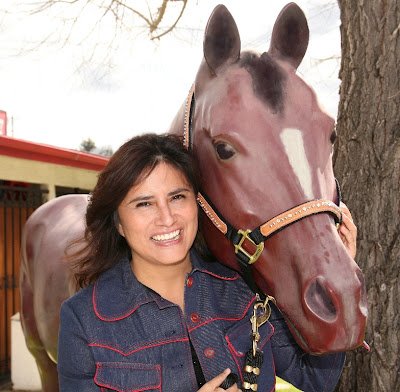








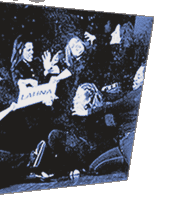

Michael, thank you for the fine reporting including on the Vroman's book reading which was a joy. I am heartbroken by the sad news about Tu Ciudad magazine...it was a smart, beautiful and necessary part of L.A. culture.
Que lástima, what a shame about the demise of Tu Ciudad magazine. Do you suppose a collection of past articles can be put together and sold as a book?
Thanks for the report, Michael.
nlf